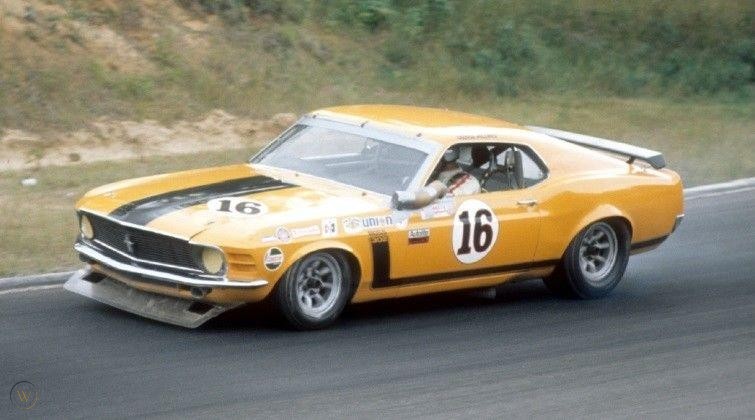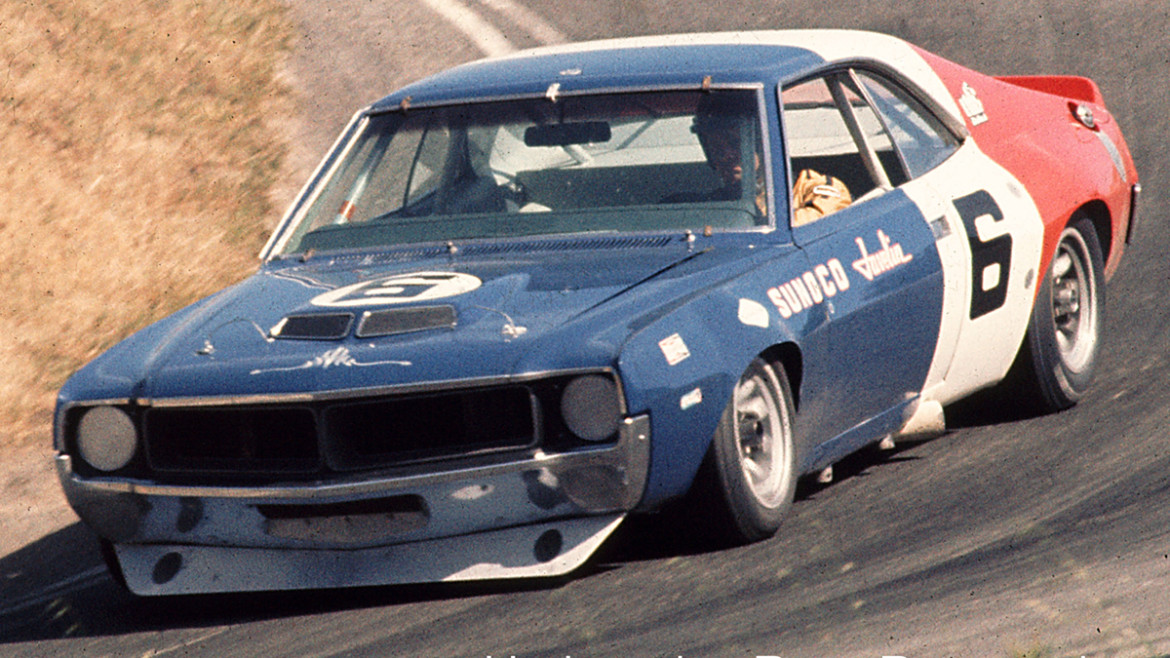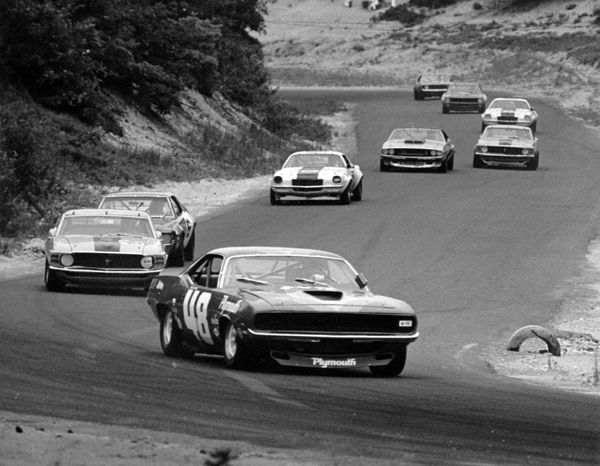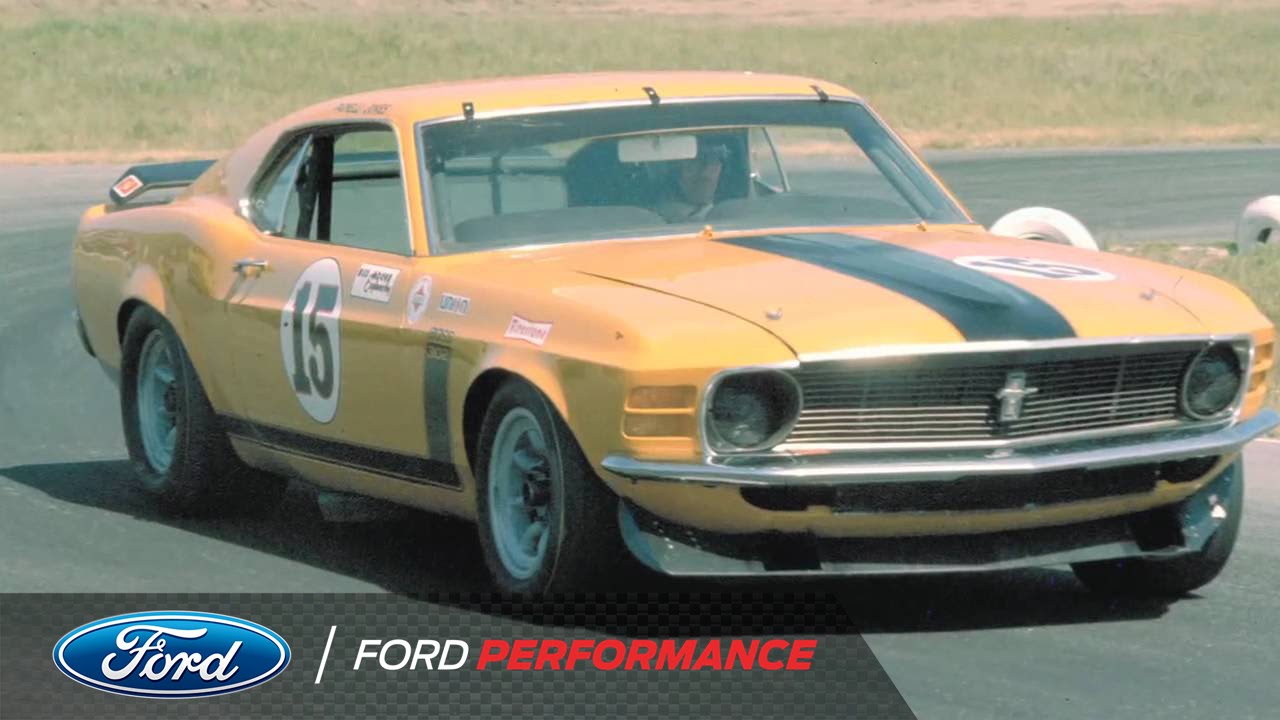The Trans Am Champions Who Never Were
 |
| 1970 Trans-Am George Follmer |
Back in 1961, Roger Maris walloped 61 home runs for the New York Yankees, breaking Babe Ruth’s 1927 mark of 60 homers. But since Maris needed seven more games to set his mark, Major League Baseball attached an asterisk to his mark, one that stood for many years.
The Trans Am Series presented by Pirelli also has its asterisks, attached to its driver champions from 1966 through 1971.
Here’s how that happened.
When the Sports Car Club of America launched what was then the Trans American Sedan Championship in 1966, the series was unique in that its focus was on the manufacturers, not the drivers.
[adinserter name="GOOGLE AD"]For its first seven years, the Trans Am attracted many of the biggest names in motorsports. The series gave America’s top sports car drivers the opportunity to mix it up with legends of Formula One, Indy cars and NASCAR.
However, the point standings were reserved for the manufacturers. Ford won titles in 1966, 1967 and 1970. Chevrolet was the 1968 champion, while American Motors came out ahead of Detroit’s “Big Three" in 1971.
For 1972, the SCCA added a drivers’ championship, won by George Follmer in an AMC Javelin.
As Trans Am grew, there were a lot of ‘what if’ questions about who would have won championships in the great early battles among stars including Dan Gurney, Mark Donohue, Parnelli Jones, Peter Revson, Follmer, Swede Savage and the other stars.
In Ford: The Dust and the Glory Volume 2, Leo Levine relates that following the 1980 season, the SCCA public relations department went back and assigned points for the 1966-71 seasons, coming up with driver championships for each year – with an asterisk attached.
Alfa GTA co-drivers Horst Kwech and Gaston Andrey shared the inaugural championship in 1966, edging Plymouth Barracuda driver Bob Johnson by one point, with Dodge Dart driver Bob Tullius another eight points back.
Roger Penske rolled out the new Chevrolet Camaro in 1967, challenging Carroll Shelby’s Ford Mustangs and Bud Moore’s Mercury Cougars. Jerry Titus topped the unofficial points in a Mustang, tallying 122 points to Mark Donohue’s 115.
 |
| Mark Donohe |
Donohue prevailed in a Camaro in 1968 and 1969. In addition to winning the manufacturer title both years, Donohue won unofficial driver championships. He won 10 races in 1968 – including eight in a row – to tally 222 points. Javelin driver George Follmer was second with 97. Donohue won six races in 1969, beating Ford Mustang driver Parnelli Jones by 26 points, 156-130.
The 1970 season was one of the greatest in Trans Am history. Parnelli Jones – driving a Bud Moore Ford Mustang – edged Donohue by only one point, 142-141. Jones won five races, including the final two to unseat Roger Penske’s star, now driving an AMC Javelin.
Sharing time for Penske between Trans Am and Indy cars, Donohue added a third unofficial Trans Am crown in 1971, winning seven races and finishing second once in eight starts in a Javelin. His exploits included the July 4 weekend sweep of the Brainerd Trans Am and Pocono Schaefer 500 Indy car race. Donohue tallied 19 points more than Follmer, who raced in both Mustangs and Javelins.
In 1972, Follmer became the first official Trans Am driver champion, beginning a streak that continues to the present. Follmer won four races for Roy Woods, driving the Javelin formerly fielded by Penske. Milt Minter took second in a Pontiac Firebird, 35 points back.
Major League Baseball officially dropped the Roger Maris asterisk in 1991. Eventually, the asterisk also disappeared from the Trans Am records, extending the official status to the early titlists.
“As far as I’m concerned, they should be considered 'Champions'," said Trans Am President John Clagett.
HISTORY
Billed as the Trans American Sedan Championship, the Series held its first race March 25, 1966, at Sebring International Raceway in Florida. Future Formula One World Champion Jochen Rindt took the overall victory and Bob Tullius won the Over 2-Liter class. Other first-year notables included A.J. Foyt, Richard Petty, Jerry Titus and Belgium's Jacky Ickx and the others may have been the star attractions during the inaugural season, but the foundation was built with regulars like Horst Kwech and Gaston Andrey in Alfa Romeos, Tullius and Tony Adamowicz in Dodge Darts, and Bob Johnson in a Plymouth Barracuda. In 1967, Mark Donohue entered the Trans Am Series, and a legend was born. Donohue earned three victories in 1967; 10 in 1968; six in 1969; three in 1970; and seven during 1971, his final season in the Series. Donohue scored a record 29 victories while driving for Roger Penske, as well as 43 top-three finishes in 55 Trans Am races, and won the championship three times (1968, 1969 and 1971), with two runner-up positions.
Donohue Dominance
 |
| 1970 – Dan Gurney leads at Bridgehampton |
The Donohue played a major role in establishing the Trans Am Series as the ultimate American automobile showdown. Donohue's Penske-prepared Camaro waged a season-long war with Parnelli Jones' Ford Mustang in 1969. Donohue prevailed, but only after winning six of the final seven races. The 1970 season began where 1969 left off, as American manufacturers waged war on the Trans Am battlefield. The Series featured Donohue and Peter Revson in AMC Javelins; Parnelli Jones and George Follmer in Ford Mustangs; Jim Hall, Vic Elford and Milt Minter in Chevrolet Camaros; Sam Posey in a Dodge Challenger; and Swede Savage in a Plymouth Barracuda.
Jones won the closest Drivers' Championship-by a one-point margin ahead of Donohue-guiding Ford to its third Trans Am Series manufacturers' title. The 1971 season was another Donohue steamroller as he won seven races, including six straight, in his AMC Javelin. Donohue easily won the Drivers' Championship, and AMC was the hands-down winner among the manufacturers.
Rule Changes
 |
| Parnelli Jones 1970 Ford Mustang |
In 1973, the Trans Am Series went through its first major rule change. FIA Group 4 cars became the dominant force as Peter Gregg and Al Holbert finished first and second, respectively, in Porsche Carreras. In 1974, Gregg won two of the three races on the schedule. Holbert won the other race as Porsche swept one through five in the points and took eight of the 30 top spots.
In 1975, the Trans Am Series was restructured based on the SCCA Club Racing's fastest production car classes. Group 4 and 5 cars were added to the mix in 1976, and the Trans Am Series went to a two-class system-Category I and II. In 1978, Greg Pickett won the Category II drivers' title, in a Chevrolet Corvette. Bob Tullius clinched the Category I championship in a Jaguar XJS.
Due to rising costs, the Category II class was eliminated at the end of the 1979 season.
Modern Era Begins
In 1980, the Trans Am Series began to utilize a handicapping system based on engine size-to-car-weight ratio, with tube-framed cars entering the picture. The tube-frame standard has remained since and signaled the start of "modern-era" Trans Am Series racing. After a 14-year absence, the Chevrolet Camaro reclaimed the Trans Am Manufacturers' Championship in 1983 as the DeAtley Racing team won 10 of 12 events, with David Hobbs winning the title ahead of Willy T. Ribbs. In 1984, Tom Gloy and Lincoln-Mercury won three races en route to his first title. Lincoln-Mercury won 11 of the 16 races, including five straight, to win its first championship.
The Roush Dynasty
Entering the Trans Am Series in 1984, the Roush Racing dynasty dominated for the next six seasons, winning 46 of the 83 races, posting 97 top-three finishes, winning 40 poles and recording 40 fastest race laps. The Roush Capris proved unbeatable in 1985, winning 12 of the 15 races as 22-year-old Wally Dallenbach, Jr. won five races and became the youngest Trans Am Series champion in history. Ribbs, also in a Roush Capri, won more races (seven) and more money ($132,933) than Dallenbach, but finished second in the title chase for the second time in his career.
Chevrolet and Lincoln-Mercury waged a fierce battle in 1986, and the title came down to the last race. With victories in five of the first six races, it appeared Chevrolet was headed for the championship, but Lincoln-Mercury staged a comeback, and Roush's drivers won four of the last five races to bring the automaker its third-straight manufacturers' title. Also in 1986, Dallenbach left Lincoln-Mercury to become Chevrolet's lead driver-and he didn't disappoint. Dallenbach won four races en route to his second-straight title, placing him among the elite company of three other back-to-back Trans Am champions up to that point: Tullius (1977 and 1978), Gregg (1973 and 1974), and Donohue (1968 and 1969).
The 1987 season saw a continuation of Lincoln-Mercury's mastery as Roush's Merkurs won 11 of the 12 races to capture a fourth-straight manufacturers' title with Pruett, who won seven races and his first Trans Am title. The Group 44 all-wheel-drive Audi Quattros rolled on to center stage in 1988 as Hurley Haywood, Hans Stuck and Walter Roehrl combined for eight victories and 19 top-five finishes. Lincoln-Mercury driver Scott Pruett won two races that year. Paul Gentilozzi won his first Trans Am Series race, and earned Oldsmobile its first Series victory.
American Muscle
The Trans Am Series returned to its roots in 1989, as American carmakers Ford, Oldsmobile and Chevrolet squared off. Ford capped a 25th anniversary celebration for the Mustang by scoring its first Manufacturers' Championship since 1970. Ford lead driver Dorsey Schroeder entered the season as a rookie, but by the end of the year, he was definitely a veteran as he owned six victories and the championship and was named Rookie of the Year. In 1990, the Trans Am Series celebrated its 25th anniversary. Chevrolet won eight races en route to its first title in seven years. Tommy Kendall collected six victories and the drivers' title. Oldsmobile started the season strong, earning victories in four of the first five outings, but finished the year second in the championship while Ford dropped to third.
In 1991, the Camaro contingent continued its dominance as Scott Sharp and Jack Baldwin scored seven victories en route to claiming the top-two places in the championship.
In 1992, Baldwin beat teammate Sharp for the championship, although it came down to the final turn of the final race of the season. Dodge made its return to the Trans Am Series that year, making for a true battle of the big three. Chevrolet and Sharp again dominated the 1993 campaign, but not without a strong fight from Ford and arch rival Ron Fellows. Fellows won three of the first five races, but Sharp then took over, earning Buz McCall's American Equipment Racing team its third-straight title. For Sharp, it was his second crown in three years, earned on the merit of six victories and nine poles.
The 1994 storyline was dominated by five former champions and a host of hungry challengers. The result was 30 track records, including five races decided by less than one second. In the end, Pruett claimed his second title in a Camaro with three victories.
The spectacular performances continued in 1995, a year without a single flag-to-flag winner, thanks in part to the introduction of an inverted "Fast Five" qualifying grid. Kendall's single victory, at the next-to-last race of the season at Road Atlanta, proved to be enough as his consistent performances earned him his second championship. Fellows, switching from a Ford Mustang to a Chevrolet Camaro for 1995, fought his way to a career-high five victories, but came up short of Kendall, earning his third-straight runner-up spot.
Five different drivers won the first five races of 1996, tying the all-time record for "season-opening" races without a repeat winner-a mark that had stood for 23 years. The season's opening rounds also produced some serious competition as eight drivers-Boris Said, Fellows, Kendall, Gentilozzi, Tony Ave, Schroeder, Jamie Galles and Sharp-led the field in the first four races, combining for 18 lead changes-just one less than the 19 total lead changes in 1995. Kendall went on win his third title in a Ford Mustang.
Kendall Dominates
The 1997 season will be remembered as the year Kendall awoke to find all of his dreams had come true. Scoring 11 consecutive victories en route to his then record fourth and third-straight championship. Kendall's remarkable winning streak set records in the Trans Am Series, SCCA Pro Racing and "major series" road racing worldwide.
Building on the exposure and momentum created in 1997, the Trans Am Series entered 1998 with BFGoodrich Tires as the series' spec radial racing tire supplier. Also new to the Trans Am Series in 1998 was the fifth-generation Chevrolet Corvette driven by Paul Gentilozzi. Gentilozzi won seven races and set seven records en route to his first Trans Am Series title-the first Drivers' Championship earned in a Corvette since Eppie Wietzes did it in 1981.
In 1999, Gentilozzi switched alliances to Ford, but it didn’t slow him down, as he captured his second consecutive title in a Mustang, with Brian Simo finishing second.
The year 2000 saw the Trans Am Series usher in new manufacturer eligibility, multi-valve engines, fuel injection and spec rear wings. It marked the return of Jaguar, brought to the party by Gentilozzi’s Rocketsports team. The title was captured by Simo in his Qvale Mangusta on the strength of three wins and seven top-five finishes, with Gentilozzi finishing in second.
The Jaguar Years
Jaguar and Rocketsports dominated three of the next four seasons, taking three manufacturers’ and drivers’ championships.
In 2001, Gentilozzi won his third Trans Am Series championship in four years and led Jaguar to its first manufacturers' title since 1978. Gentilozzi won four races that year, including three straight early in the season.
Boris Said powered his Panoz Esperante to eight wins in 2002 to earn his first Trans Am Series championship, as Jaguar used the season to develop a multi-valve engine program that would prove to be nearly unbeatable the next year.
The Rocketsport Jaguars returned with a vengeance in 2003 as Scott Pruett won eight of 10 races en route to his third title. In 2004, the stage was set for a Rocketsports showdown featuring four-time champ Kendall and three-time titlist Gentilozzi. Both drivers entered the season in hot pursuit of Donohue’s record for most wins (29) with Kendall leading the charge with 26 wins, but followed closely by Gentilozzi at 24 wins.
The year belonged to Gentilozzi, who gained his fourth title on the strength of five wins in eight starts. His final victory of the season came in Denver to tie Donohue at 29 career wins.
The 2005 season was one of the most competitive in years. A scant 19 points separated the top four drivers with just two races to go, as Derhaag/Corvette ace Randy Ruhlman, thanks in large part to a win at Cleveland, led the points chase by a single point. German Klaus Graf, driving a Rocketsports Jaguar, finished out of the top 10 in three of the first four races but turned things around in a big way with the season headed for the home stretch. He won the final three races (Denver, Road America and Montreal) to secure his first drivers’ title and Jaguar’s third straight manufacturers’ title.
Gentilozzi, ran a limited schedule in 2005, but remained a factor when he entered. He won in the streets of Toronto to become the all-time leader in career wins with 30. The other feat of note was Greg Pickett winning in Edmonton, to become the first driver to win in four different decades.
Significant news was made off track, as SCCA Pro Racing assumed series’ ownership and management. Just two races were held in 2006, and both were run at Ray Irwin’s Heartland Park Topeka. The field was mostly GT-1 club racers, but it did include several Trans Am “regulars", including Gentilozzi. Gentilozzi earned his 31st career win and added a second in the other race, which propelled him to his fifth title.
Trans Am Series was shuttered by SCCA Pro Racing following the 2006 season. At the time, it marked the end of the road, despite an impressive run of 41 years of continuous operation. ? ?The Trans Am was brought back to life for the 2009 season, with the technical and sporting regulations based on GT-1 club rules. Veteran Tomy Drissi won the Portland race and took the Drivers’ title while Tony Ave was the series’ runner up while former Champion Graf made the most of his two appearances – winning two of two (VIR and Mosport).
Ave turned in monster performances in 2010 and 2011, taking six wins each season to win back to back titles.
Also in 2011, Amy Ruman became the first woman in series history to win a race, accomplishing the feat in the season finale at Road Atlanta.
